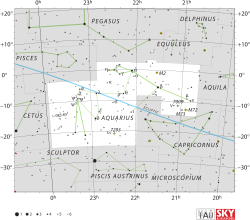Pi Aquarii
| Observation data Epoch J2000 Equinox J2000 |
|
|---|---|
| Constellation | Aquarius |
| Right ascension | 22h 25m 16.62285s |
| Declination | +01° 22′ 38.6346″ |
| Apparent magnitude (V) | +4.66 |
| Characteristics | |
| Spectral type | B1 Ve |
| U−B color index | –0.98 |
| B−V color index | –0.03 |
| Variable type | γ Cas |
| Astrometry | |
| Radial velocity (Rv) | +4.0 km/s |
| Proper motion (μ) |
RA: +17.83 mas/yr Dec.: +2.41 mas/yr |
| Parallax (π) | 4.17 ± 0.28mas |
| Distance | 780 ± 50 ly (240 ± 20 pc) |
| Details | |
| Mass | 10.7 ± 0.7 M☉ |
| Radius | 6.2 R☉ |
| Luminosity | 7,302 L☉ |
| Temperature | 27,094 K |
| Rotational velocity (v sin i) | 215 km/s |
| Age | 10.0 ± 5.0 Myr |
| Other designations | |
| Database references | |
| SIMBAD | data |
Pi Aquarii (π Aqr, π Aquarii) is the Bayer designation for a binary star in the equatorial constellation of Aquarius. It shares the traditional name Seat with Delta Aquarii, where it has long been misspelled Skat. It may be from the Arabic word ši'at, meaning "a wish". This system has an apparent visual magnitude of a mean apparent magnitude of +4.57. Based upon parallax measurements, it is located at a distance of roughly 780 light-years (240 parsecs) from Earth.
This is a binary star system with an orbital period of 84.1 days. The primary component is a B-type main sequence star with a stellar classification of B1 Ve. This is a large star with nearly eleven times the mass and over six times the radius of the Sun. Pi Aquarii shines about 7,300 times as brightly as the Sun. This energy is being radiated from its outer atmosphere at an effective temperature of 27,094, giving it the blue-hued glow of a B-type star. It is spinning rapidly with a projected rotational velocity of 215 km/s.
Pi Aquarii is notable for having undergone a transition from a Be star (showing hydrogen emission lines) into an ordinary B-type star. It is classified as a Gamma Cassiopeiae typevariable star and its brightness varies from magnitude +4.45 to +4.71; a range of 0.28. The dominant variability period, 83.8 ± 0.8 days, is nearly the same as the orbital period. Pi Aquarii has a reasonable chance of becoming a supernova some day.
...
Wikipedia

